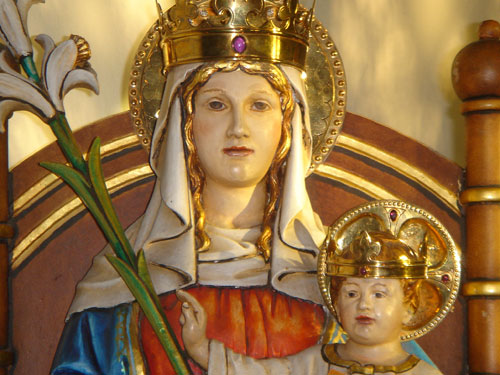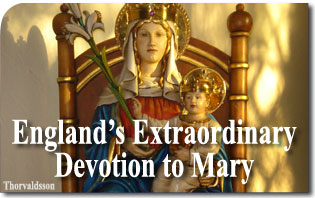by Ben Broussard
When mentioning the country of England, images immediately come to mind of the Houses of Parliament, double-decker buses, high tea and…devotion to Mary?
In a book published in the late 19th century titled Pietas Mariana Britannica: A History of Devotion to the Mother of God in England, Mr. Edmund Waterton takes his readers far from all the modern stereotypes to a time when England was known as Dos Mariae, Our Lady’s Dowry.
During the Middle Ages, devotion to the Blessed Virgin Mary thrived in every European country, and England was no exception. On the contrary, from the cosmopolitan city of London to the fishing villages of Cornwall, from the northern stretches of Yorkshire to the storied city of Canterbury, every corner of the country had its own particular way of paying homage to the Mother of God.
The view of England as a cold, closed nation marked by a Protestant spirit contrasts greatly with the realm portrayed by Waterton. Studying in continental Europe during his youth, the author makes known his initial dismay at the lack of Catholic piety in his native land. However, through the influence of his professors and investigating the hidden history of his country, the fruits of his research have yielded a beautiful tome which details the marvelous ways in which Englishman paid homage to their Heavenly Queen.
A Marian Culture
Mr. Waterton clearly demonstrates how for centuries, being English and being devoted to Mary were synonymous. In every parish in the land, laypeople would meet daily to recite the Little Office of Our Lady, which was commonly memorized and prayed while travelling. Students at Oxford and Cambridge were required to recite Matins from the Office of Our Lady while making their beds in the morning, as well as pray the Rosary while hearing the morning Mass. Beggars would sing the Salve Regina when asking for alms, and Saturdays were days of fasting and almsgiving in Our Lady’s honor. Expectant mothers were given girdles with the text of the Magnificat inscribed on them. The author shows just how ingrained Marian devotion was by enumerating how vast numbers of churches, chapels, bells, gates, estates, lands, guilds and entire cities came to be consecrated to Mary in every part of England.
Mr. Waterton spends the entire second half of the book detailing the particular devotions of more than 200 English villages and towns, from the more obscure such as Our Lady of Pity at Southwold, to the impressive array of Marian sanctuaries in London and Coventry. As he makes clear in this second section, Catalogue of Shrines, Sanctuaries, Offerings, Bequests, and Other Memorials of the Piety of Our Forefathers, the research was limited due to the numerous documents which had been destroyed by the time he was writing in the late 19th century. He makes clear that many volumes could be filled had there not been so much devastation wrought by previous generations. Nonetheless, the reader cannot fail to be impressed by the widespread and centuries-long piety in all parts of the kingdom.

Our Lady of Walsingham, a centuries old devotion to Our Lady in England.
Photo credit Thorvaldsson.
Our Lady Comes to England
The great Mother of God even graced the island with her presence when she appeared at Walsingham and commanded a sanctuary built in her honor, and for centuries called the Holy Land of Walsingham. In 1061 the widow Richeldis received a vision of the Blessed Virgin, and coming to the site Our Lady had designated for the sanctuary, stood astonished as the angels proceeded to construct the shrine exactly the same as the Holy House at Nazareth. Mr. Waterton makes clear the striking similarities between the shrine at Walsingham with the Holy House of Loreto, Italy.
Devotion grew over the centuries, and every king and queen of England from St. Edward the Confessor up to and including Henry VIII and Catherine of Aragon walked barefoot as pilgrims from London to Walsingham, a distance of over 120 miles.
The most popular place of pilgrimage in England was not only frequented by the English, but Europeans from various countries would travel there to seek the intercession of Our Lady of Walsingham for their temporal and spiritual needs.
Much is Lost, Much to be Regained
Since the time Mr. Waterton was writing, there has been a significant loss in the level of the average reader. Many reading his work today will have trouble with extensive passages in Latin and French which he leaves untranslated, as well as the occasional section in Old English which may take some moments to decipher.
The reader who perseveres, however, will be mourning the much greater loss of such a vibrant Marian culture that thrived prior to the Protestant Revolt. Indeed, the facts described within these pages make Henry VIII and his contemporaries’ break with the Church all the more monstrous. If little survived to the days of Mr. Waterton in the 19th century due to the unprecedented iconoclasm of previous eras, the same can be said with greater certainty today as to the extant legacy of the Marian devotion of our ancestors.
The author leaves no stone unturned in such a monumental work extolling the devotion to the Queen of Heaven in the land of England, and leaves his reader with the distinct hope that what was once so commonplace can one day be regained. May Our Lady of Walsingham place this wonderful book in the hands of those who need it most, and may devotion to her once again thrive among all Englishmen and their descendants throughout the world.


No comments:
Post a Comment